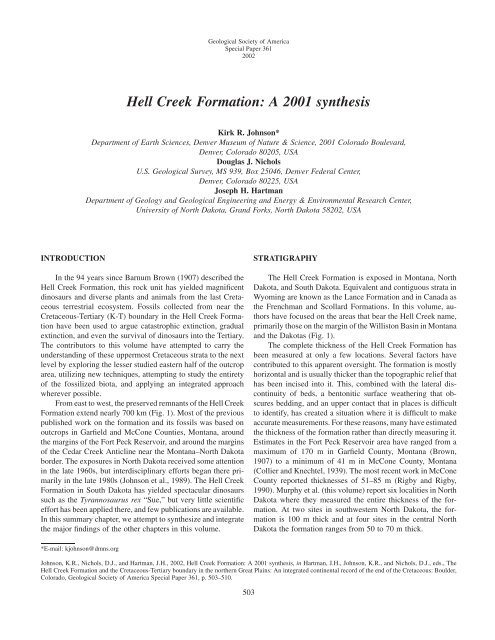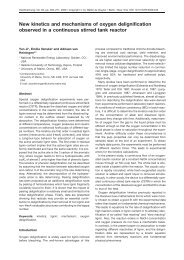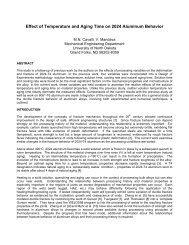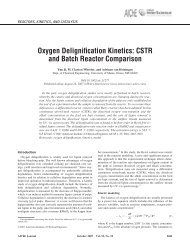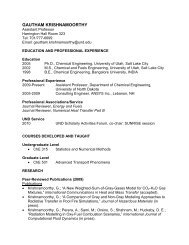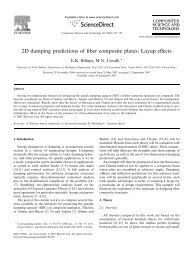Hell Creek Formation: A 2001 synthesis - Engineering & Mines
Hell Creek Formation: A 2001 synthesis - Engineering & Mines
Hell Creek Formation: A 2001 synthesis - Engineering & Mines
You also want an ePaper? Increase the reach of your titles
YUMPU automatically turns print PDFs into web optimized ePapers that Google loves.
<strong>Hell</strong> <strong>Creek</strong> <strong>Formation</strong>: A <strong>2001</strong> <strong>synthesis</strong> 505Figure 2. Stratigraphic cross sectionfrom <strong>Hell</strong> <strong>Creek</strong> to Glendive, Montana,to Marmarth, to Huff, North Dakotashowing thickness of <strong>Hell</strong> <strong>Creek</strong> and adjacentstrata. Black and white bars showposition and results of paleomagneticsections of Hicks et al. (this volume)near Marmarth and Lund et al. (this volume)near Glendive, Montana, and Huff,North Dakota. Datum is top of <strong>Hell</strong><strong>Creek</strong> <strong>Formation</strong>. The Firesteel ligniteseam divides the lower and upper <strong>Hell</strong><strong>Creek</strong> <strong>Formation</strong> in South Dakota, southof the line of section.a 45 km length of the Little Missouri River. Both groupsidentified three polarity subchrons that they interpret as C29n,C29r, and C30n. In all 10 sections, the palynologically definedK-T boundary occurs in a reversed interval interpreted as C29r.The thickness of C29r and the position of the K-T boundaryrelative to the base of the subchron are variable, but in general,the K-T boundary occurs in the basal third of the subchron.Lund et al. interpret this variation to represent a diachroneityof the top of the <strong>Hell</strong> <strong>Creek</strong> <strong>Formation</strong> and argue that the topof the formation is older to the east than to the west. Hicks etal. see this same amount of variation in the position of theK-T boundary within their local transect, but argue that localdiastems within the <strong>Hell</strong> <strong>Creek</strong> are responsible for the variation.In the most complete marine sections, the K-T boundary occursslightly above the middle of C29r (Smit, 1999).Obradovich (in Hicks et al., this volume) recalibrates theage of the K-T boundary to 65.51 Ma by normalizing manyrecently determined radiometric ages to a uniform standard.The K-T boundary and the beginning and end of magnetic polaritysubchron C29r represent time lines. Using estimateddurations for the Cretaceous and Paleocene portions of C29r(D’Hondt et al., 1996), the age of the K-T boundary (Hicks etal., this volume), and the thickness of rock between those timelines, it is possible to estimate a sediment accumulation rate forthe <strong>Hell</strong> <strong>Creek</strong> <strong>Formation</strong>. Both Lund et al. and Hicks et al. usevariants of this method and the assumption of a uniform sedimentaccumulation rate to make estimates of the duration of theentire formation. Lund et al. estimate a duration of 2.5 m.y.,whereas Hicks et al. estimate 1.36 m.y. The difference in theseestimates is due to three variables: (1) variable formation thickness,(2) different estimations for the duration of C29r, and(3) different thicknesses or accumulation rates of the Cretaceousportion of C29r. The shorter duration is supported by theabsence of C30r in two tightly sampled sections of the lower<strong>Hell</strong> <strong>Creek</strong> <strong>Formation</strong> in Bowman County, North Dakota.Nonetheless, the difference between the two estimates illustratesthe need for better age control at the base of the formation.CHEMOSTRATIGRAPHYArens and Jahren (this volume) present analyses of stablecarbon isotopes from sedimentary rock samples in four sectionsin southwestern North Dakota. The d 13 C shift of 1.5‰–2‰ thatmarks the K-T boundary in marine sections was detected in allfour sections, but not always in precise correlation with thepalynologically defined K-T boundary. Additional variations ofd 13 C throughout the formation have the potential to define anisotope stratigraphy, allowing for independent correlation betweensections of the <strong>Hell</strong> <strong>Creek</strong> <strong>Formation</strong>. The differencesbetween these results and the palynological record suggest thatchemostratigraphy needs to be refined at more sites where theK-T boundary clay layer is present.PALYNOLOGY AND PALEOBOTANYNichols (this volume) documents the palynology of the entire<strong>Hell</strong> <strong>Creek</strong> <strong>Formation</strong>, and Nichols and Johnson (this volume)use palynology to locate the K-T boundary in 17 sections.In several sections north of Marmarth, North Dakota, they identifya zone as thick as 3 m at the base of the Ludlow Memberof the Fort Union <strong>Formation</strong> that contains Cretaceous palynomorphs.They name this the Fort Union strata of Cretaceousage. Pearson et al. (this volume) have discovered a partial ceratopsianskeleton in this unit. Hotton (this volume) addresses
506K.R. Johnson, D.J. Nichols, and J.H. Hartmanthe K-T boundary in the Fort Peck Reservoir region and arguesthat dramatic changes in the palynoflora at the K-T boundarysupport the impact hypothesis. Kroeger (this volume) usespalynology to discuss sedimentological facies within the <strong>Hell</strong><strong>Creek</strong>.Johnson (this volume) describes the megafloral paleobotanyof the <strong>Hell</strong> <strong>Creek</strong> and lower Fort Union <strong>Formation</strong>s andrecognizes 380 megafloral morphotypes. Of this total, 328 morphotypesoccur in the <strong>Hell</strong> <strong>Creek</strong> <strong>Formation</strong>. This is more thanthree times the number of palynofloral taxa described by Nicholsfrom the same beds, despite the huge difference in samplesize (Nichols observed 450 000 playnomorphs and Johnsonsaw 30000 megafossils). This indicates that megafossils samplethe flora at a higher taxonomic resolution than palynomorphs(species rather than genera or families). The vegetationof the <strong>Hell</strong> <strong>Creek</strong> is dominated by arboreal angiosperms,whereas ferns and conifers are more abundant in the palynoflorathan the megaflora. Hotton’s statistical analyses are based on a<strong>Hell</strong> <strong>Creek</strong> palynoflora composed of about three times as manyspecies as recognized by Nichols, because these authors tooksomewhat different taxonomic approaches. It is significant thatboth authors conclude that about one-third of the palynoflorabecame extinct at the K-T boundary. Johnson, whose fossil dataset has higher taxonomic resolution, concludes that 80% ofthe <strong>Hell</strong> <strong>Creek</strong> flora did not survive the terminal Cretaceousextinction event. These results are not in disagreement, but insteadresult from sampling a biotic record at different taxonomiclevels.The depth of understanding that comes from combiningthe strengths of palynology and megafloral paleobotany is impressive.Because pollen and leaves are derived from the samevegetation, interpretations based on one organ can be extrapolatedto the other. The high stratigraphic resolution of palynologyallows for the effects of the Cannonball transgression (theinitiation of lignite deposition) to be separated from the effectsof the impact event that deposited iridium and shocked mineralson the landscape. Megafossils lack that stratigraphic resolution,but offer species-level taxonomic resolution, which allows fora more precise assessment of the magnitude of the extinction.In addition, the paleoclimatic abilities of foliar physiognomyallow for the identification of Late Cretaceous climate trends.A dramatic warming, recorded by fossil leaves that first occur20 m below the top of the <strong>Hell</strong> <strong>Creek</strong> <strong>Formation</strong> (Johnsonand Wilf, 1996), also is recorded in the record of marine foraminiferanear Antarctica (Stott and Kennett, 1990).VERTEBRATE PALEONTOLOGYRussell and Manabe (this volume) provide a brief overviewof the dinosaurian fauna of the <strong>Hell</strong> <strong>Creek</strong> <strong>Formation</strong>. Theydiscuss the much-collected but rarely mentioned monotypic Edmontosaurusdinosaur bone beds found in the lower part of theformation in central South Dakota and adjacent North Dakota(Christians, 1992). These bone beds occur above the Fox Hills–<strong>Hell</strong> <strong>Creek</strong> formational contact but generally below the Firesteellignite zone, which marks the contact between the lowerand upper <strong>Hell</strong> <strong>Creek</strong> <strong>Formation</strong> in central South Dakota. Thepresence and nature of these bone beds are reminiscent ofmonotypic ceratopsian bone beds described by Eberth (1998,written commun.) from the Dinosaur Park <strong>Formation</strong> of Alberta.He suggests that these deposits were formed by stormsurge across a low-relief coastline that provided both the mechanismof death by drowning and the mode of burial.Pearson et al. (this volume) combine vertebrate micrositesand isolated dinosaur occurrences to plot the distribution of61 vertebrate taxa relative to the K-T boundary in westernmostNorth Dakota and South Dakota. All common taxa occurthroughout the formation and dinosaurs are present in all localities.There is a zone 2 m thick at the top of the formationin which no bones have been found, and Pearson et al. interpretthis to be related to a change in the sedimentological nature ofthe interval containing the <strong>Hell</strong> <strong>Creek</strong>–Fort Union formationalcontact. This gap has been long recognized (Clemens, this volume)and remains controversial, but Pearson et al. have clarifiedthe issues by providing the first documentation of a large dataset precisely located in reference to both the formational contactdatum and the K-T boundary.Hunter and Archibald (this volume) document the mammalianfauna of the <strong>Hell</strong> <strong>Creek</strong> <strong>Formation</strong> in southwesternNorth Dakota and show it to be a typical Lancian fauna. Holroydand Hutchison (this volume) compare the turtle fauna ofsouthwestern North Dakota with that of the type <strong>Hell</strong> <strong>Creek</strong> inMontana and other Lancian sites elsewhere and document someregional differences in the turtle faunas suggestive of latitudinalgradients.Hoganson and Murphy document the vertebrate fauna ofthe marine Breien Member of the <strong>Hell</strong> <strong>Creek</strong> <strong>Formation</strong> andconclude that it more closely resembles the fauna of the underlyingFox Hills <strong>Formation</strong> than the overlying fauna of themarine Cannonball Member of the Fort Union <strong>Formation</strong>. Pearsonet al. also noted the presence of a number of fish taxa inthe <strong>Hell</strong> <strong>Creek</strong> <strong>Formation</strong> in southwestern North Dakota thatindicate proximity of brackish or marine water.Clemens (this volume) provides a detailed review of therecent and historical work in the <strong>Hell</strong> <strong>Creek</strong> type area and addressesthe role of fossil mammals for understanding the terminalCretaceous event. He concludes that immigration playeda major role in the turnover of mammalian faunas before theK-T boundary. He discusses Paleocene vertebrate sites in theuppermost <strong>Hell</strong> <strong>Creek</strong> section in Garfield County, Montana.These observations appear to be in agreement with the work ofNichols and Johnson and Lund et al., who used palynology andmagnetostratigraphy, respectively, to argue that the upper contactof the <strong>Hell</strong> <strong>Creek</strong> <strong>Formation</strong> is diachronous.INVERTEBRATE PALEONTOLOGYHartman and Kirkland (this volume) document the previouslyunpublished invertebrate fauna collected by Charles Frye
<strong>Hell</strong> <strong>Creek</strong> <strong>Formation</strong>: A <strong>2001</strong> <strong>synthesis</strong> 507in the 1960s and interpret possible variations in salinity basedprimarily on molluscan associations from the Fox Hills <strong>Formation</strong>through the end of the Cretaceous. This fauna was derivedprimarily from the Breien Member of the <strong>Hell</strong> <strong>Creek</strong> butalso includes specimens from higher and lower in the formation.Many of these species are interpreted to have inhabitedbrackish or marine waters, suggesting that much of the lower<strong>Hell</strong> <strong>Creek</strong> in the Missouri River Valley was deposited close tothe remnant Cretaceous Western Interior Seaway. Hogansonand Murphy (this volume) present ichnofossil evidence of marineconditions in the Breien Member and also document theexistence of a poorly preserved specimen of the zonal ammoniteJeletzkytes cf. J. nebrascensis. Jeletzkytes nebrascensis representsthe youngest zone of the Western Interior ammonite zonation.Examples of this ammonite are known from the FoxHills <strong>Formation</strong> and the Elk Butte Member of the Pierre Shale(Kennedy et al., 1998). The poor preservation of the <strong>Hell</strong> <strong>Creek</strong>specimen ammonite is unfortunate considering its potential biostratigraphicsignificance.PALEOENTOMOLOGYLabandeira et al. (this volume) apply a novel approach tounderstanding the insect fauna of the <strong>Hell</strong> <strong>Creek</strong> and Fort Union<strong>Formation</strong>s by studying the insect damage found on the fossilleaves described by Johnson (this volume). They document 49types of insect damage, including foliage feeding, mining, galling,and piercing and sucking. Only 22 types of insect damagecross the K-T boundary extinction event, and of these, 55% werethe more generalized feeding types. They interpret this to suggestthe extinction of specialist herbivores at the K-T boundary.AGE OF THE HELL CREEK FORMATIONAge of the upper contact of the <strong>Hell</strong> <strong>Creek</strong> <strong>Formation</strong>The age and duration of the <strong>Hell</strong> <strong>Creek</strong> <strong>Formation</strong> are longstandingand still partially unanswered questions. The uppercontact of the formation was recognized to approximate theK-T boundary by Dorf (1940, 1942) and Brown (1952), althoughit was not directly correlated to the marine K-T boundary.Ross (1940), Fox and Ross (1942), and Fox and Olsson(1969) described the early Paleocene (Danian) foraminifera ofthe Cannonball Member of the Fort Union <strong>Formation</strong> andshowed that the terrestrial K-T boundary could be roughly correlatedto the marine K-T boundary. More precise correlationfollowed with the use of palynology to identify the K-T boundaryand the discovery of the iridium anomaly at a level verynear the top of the <strong>Hell</strong> <strong>Creek</strong> <strong>Formation</strong> in the type area byAlvarez (1983) and Bohor et al. (1984), and in southwesternNorth Dakota by Johnson et al. (1989) and Nichols et al. (2000).Magnetostratigraphy in the <strong>Hell</strong> <strong>Creek</strong> type area (Archibald etal., 1982; Swisher et al., 1993), near Glendive (Lund et al., thisvolume), Ekalaka (J. Archibald, 1988, written commun.), andMarmarth (Hicks et al., this volume), places the palynologicalK-T boundary in a zone of reversed polarity interpreted as subchronC29r. Lund et al. (this volume) show two sections wherethe top of the <strong>Hell</strong> <strong>Creek</strong> <strong>Formation</strong> is located very close to thebase of C29r, which suggests to them that the <strong>Hell</strong> <strong>Creek</strong> depositionterminated locally before the end of the Cretaceous.Nichols and Johnson (this volume) use palynology to show thatthe K-T boundary and the formation contact are separated by0–270 cm in southwestern North Dakota. This result is similarto work near Ekalaka, Montana; Buffalo, South Dakota (Nichols,1999, written communication); the <strong>Hell</strong> <strong>Creek</strong> type area(Hotton, this volume), and central North Dakota (Murphy et al.,1995). Thus the upper contact of the <strong>Hell</strong> <strong>Creek</strong> over most ofits outcrop area is roughly the age of the K-T boundary plus orminus the time taken to deposit as much as 3 m of sediment.On the basis of the thickness of C29r, 3 m of <strong>Hell</strong> <strong>Creek</strong> sedimentwould likely have accumulated in 30–100 k.y. Thus, overan east-west transect of the <strong>Hell</strong> <strong>Creek</strong> <strong>Formation</strong>, the uppercontact is slightly diachronous.Age of the lower contact of the <strong>Hell</strong> <strong>Creek</strong> <strong>Formation</strong>Estimates of the age of the lower contact of the <strong>Hell</strong> <strong>Creek</strong><strong>Formation</strong> are few and poorly delimited. Hicks et al. (this volume)attempted to date a volcanic ash from Doaks Butte nearthe base of the formation on the South Dakota-North Dakotaborder, but did not achieve a tight-enough spread of dates to besignificant. The age of the youngest dated ammonite below the<strong>Hell</strong> <strong>Creek</strong> is the 70.15 Ma Baculites grandis zone that occursin the uppermost Bearpaw Shale in the Fort Peck Reservoirarea, and in the uppermost Pierre Shale in the Cedar <strong>Creek</strong>Anticline. The 69.57 Ma Baculites clinolobatus zone underliesthe formation in central North Dakota, as do the undated Hoploscaphitesbirkelundi, Hoploscaphites nicolletti, and Jeletzkytesnebrascensis zones. Hicks et al. (this volume) and Lundet al. (this volume) provide estimates of the age of the base ofthe <strong>Hell</strong> <strong>Creek</strong> <strong>Formation</strong> based on extrapolation of sedimentaccumulation rates: their estimates are 1.36 Ma and 2.5 Ma,respectively. There is a distinct possibility that the base of theformation is significantly diachronous. The oldest ammonitezone in the uppermost portion of the Pierre Shale below the<strong>Hell</strong> <strong>Creek</strong> <strong>Formation</strong> is the Baculites cuneatus zone, whichoccurs near Ekalaka, Montana. At nearly 73 Ma, this wouldrepresent the absolute maximum age for the base of the formation.Basal <strong>Hell</strong> <strong>Creek</strong> unconformityThe nature of the basal contact of the <strong>Hell</strong> <strong>Creek</strong> <strong>Formation</strong>is germane to the discussion of the age of its base. In his originaldescription, Brown (1907) discussed the erosional basal contactof the <strong>Hell</strong> <strong>Creek</strong> on the underlying Fox Hills <strong>Formation</strong>. Subsequentwork in the Fort Peck Reservoir region identified basal<strong>Hell</strong> <strong>Creek</strong> channels containing quartzite cobbles up to 10 cm
508K.R. Johnson, D.J. Nichols, and J.H. Hartman(Bauer, 1925; Jensen and Varnes, 1964). The uppermost unit ofthe Fox Hills <strong>Formation</strong> in the Fort Peck Reservoir and Cedar<strong>Creek</strong> Anticline areas is the Colgate Member, a stark white,leached, 10–20-m-thick sandstone with an eroded upper surface.There has been continuing debate over the extent and magnitudeof the basal <strong>Hell</strong> <strong>Creek</strong> unconformity. Dobbin and Reeside(1929) studied this issue carefully over the entire RockyMountain region and concluded that there was not a significantregional unconformity. Belt et al. (1997) combined sedimentologicaland magnetostratigraphic data to argue that this unconformitywas regional and represents a significant period oftime between the deposition of the Fox Hills and the <strong>Hell</strong> <strong>Creek</strong><strong>Formation</strong>s. Several observations cause us to regard their hypothesisfavorably, as seen in the accompanying Wheeler diagram(Fig. 3). Evidence for an unconformity includes the extrabasinalconglomerate lag at the base of the <strong>Hell</strong> <strong>Creek</strong>, thefact that none of the magnetostratigraphic studies have identifiedsubchrons C30r or C31r, and the absence of lignite beds inthe base of the <strong>Hell</strong> <strong>Creek</strong> <strong>Formation</strong>. Lignite beds are commonlypresent in a regression sequence as the beds shorewardof the strand. Such a situation occurs in the Denver Basin,where the Laramie <strong>Formation</strong>, the unit immediately above theFox Hills <strong>Formation</strong>, is rich in coal seams. Figure 3 representsa fairly radical view of the genesis of the <strong>Hell</strong> <strong>Creek</strong> <strong>Formation</strong>.It implies that the formation was deposited in response to theearly inception of the Cannonball transgression rather than simplyrepresenting the landward component of the Fox Hills regression,as has long been the consensus.PROXIMITY OF THE WESTERN INTERIOR SEAWAYAnalysis of the easternmost <strong>Hell</strong> <strong>Creek</strong> <strong>Formation</strong> outcropsshows that the Cretaceous Western Interior Seaway, oncethought to be absent in <strong>Hell</strong> <strong>Creek</strong> time, was probably presentFigure 3. Wheeler diagram based on Figure 2 using Cretaceous-Tertiary (K-T) boundary as datum. Inthis interpretation, there is large unconformity between base of <strong>Hell</strong> <strong>Creek</strong> <strong>Formation</strong> and top of FoxHills <strong>Formation</strong>. This unconformity is based on (1) Hicks et al. (1999) estimate for duration of 1.36m.y. for <strong>Hell</strong> <strong>Creek</strong> <strong>Formation</strong> near Marmarth; (2) absence of magnetic polarity subchrons C30r, C31n,and C31r in well-sampled base of <strong>Hell</strong> <strong>Creek</strong> near Doaks Butte and Sunset Butte, North Dakota; (3)the historically well documented scoured contact of <strong>Hell</strong> <strong>Creek</strong> <strong>Formation</strong> on Fox Hills <strong>Formation</strong>; and(4) absence of lignite beds in base of <strong>Hell</strong> <strong>Creek</strong> <strong>Formation</strong>, a situation that would be expected if the<strong>Hell</strong> <strong>Creek</strong> represented a regressional deposit laterally and temporally equivalent to the Fox Hills <strong>Formation</strong>.This diagram represents end-member minimum-duration interpretation for <strong>Hell</strong> <strong>Creek</strong> <strong>Formation</strong>.Patterns are only to distinguish units and have no lithologic implications. White space indicatestemporal hiatus. Single and partial ammonite specimen identified as Jeletzkytes cf. J. nebrascensis wasfound in Breien Member (Hoganson and Murphy, this volume). Highest ammonite zones that havereliable radiometric dates are middle of Baculites grandis zone (70.15 0.65 Ma) and top of Baculitesclinolobatus zone (69.57 0.37 Ma), both from Red Bird, Wyoming (Hicks et al., 1999).
<strong>Hell</strong> <strong>Creek</strong> <strong>Formation</strong>: A <strong>2001</strong> <strong>synthesis</strong> 509somewhere relatively close to the present eastern erosioncontrolledoutcrop margin. Evidence of the presence of the seawayexists in the lithologies and ichnofossils described byMurphy et al. (this volume) and Hoganson and Murphy (thisvolume), the vertebrate fossils described by Pearson et al. (thisvolume) and Hoganson and Murphy (this volume), and thebrackish and marine invertebrate faunas described by Hogansonand Murphy (this volume) and Hartman and Kirkland (this volume).If the monotypic dinosaur bone beds of central SouthDakota represent storm-surge–related mass drowning and burials,then they are one more argument for a near-coastal settingfor the <strong>Hell</strong> <strong>Creek</strong> <strong>Formation</strong>. Correlation and interpretation ofelectric logs by Cherven and Jacob (1985) indicated that uppermostCretaceous marine deposits are present in the subsurfaceof the Williston Basin, suggesting that the entire thicknessof <strong>Hell</strong> <strong>Creek</strong> in North Dakota and South Dakota was subjectto some marine influence.In this nontraditional interpretation, the regression of theCretaceous seaway, represented by the Fox Hills <strong>Formation</strong>,was followed by a fall in base level that caused sediment bypassand erosion in the area that would later be covered by the <strong>Hell</strong><strong>Creek</strong> <strong>Formation</strong>. Eventually regression ceased, and the baselevel stabilized and then began to rise. It was during this timethat the deposition of the <strong>Hell</strong> <strong>Creek</strong> <strong>Formation</strong> began. Smallscaletransgressions during <strong>Hell</strong> <strong>Creek</strong> time resulted in thedeposition of the Breien Member and the Cantapeta advance(Murphy et al., this volume). The distal effects of these or similartransgressions were the few lignite beds known in the <strong>Hell</strong><strong>Creek</strong>, most notably the Firesteel lignite in central South Dakota.The Cannonball transgression began shortly before theK-T boundary. The abundant lignite beds of the Ludlow andTullock Members of the Fort Union <strong>Formation</strong> are a testimonyto the rise in base level and increase in coastal aggradationcaused by a rapidly transgressing Paleocene seaway. That the<strong>Hell</strong> <strong>Creek</strong>–Fort Union formational contact, which is definedmost often by the inception of peat deposition, is nearly isochronousover a depositional slope of more than 500 km arguesfor the rapidity of this event and the flatness of the terrain.K-T BOUNDARYData presented in this volume represent the first integratedassessment of a complete terminal Cretaceous terrestrial biota.Never before have plants, vertebrates, and insects been observedtogether in a well-dated stratigraphic context that containsthe physical evidence of the K-T impact event and itsassociated shift in carbon isotopes. In addition, many of thesechapters also assess the biota of the overlying Paleocene beds.The debate concerning the biotic effects of the K-T impactevent has been an enduring one. Some workers even questionthe existence of a major K-T extinction of terrestrial biota(Sarjeant and Currie, <strong>2001</strong>). One of the reasons that this controversypersists is that there have been very few integratedstudies with adequate sample density to refute the apparentgradualism resulting from small samples. A second reason isthat most arguments have relied on individual groups ratherthan entire biotas. The pattern that emerges in this volume isone of substantial, abrupt, biota-wide devastation at the K-Tboundary. Furthermore, high-resolution stratigraphy allows forthe effects of the K-T event to be separated from those areattributed to Late Cretaceous climate change and transgressionof the Cannonball Seaway.FUTURE QUESTIONSThis volume has raised and refined a number of questions.Perhaps the most obvious is the unresolved age of the base ofthe <strong>Hell</strong> <strong>Creek</strong> <strong>Formation</strong> and its implication for the durationof <strong>Hell</strong> <strong>Creek</strong> deposition. Does the formation have a durationof 1.36 m.y., as suggested by Hicks et al. (this volume), or doesit fill all of the time between the highest dated ammonite andthe K-T boundary, a span of 4.6 m.y.? Is there really a majorunconformity between the Fox Hills and <strong>Hell</strong> <strong>Creek</strong> <strong>Formation</strong>s?The answers to these questions have tremendous implicationsfor our ability to assess the rate of biotic change beforethe K-T boundary event. Despite the presence of bentonites andthe efforts of Hicks et al., there have been no precise radiometricages derived from the <strong>Hell</strong> <strong>Creek</strong> <strong>Formation</strong>.The issue of the vertebrate fossil-free gap in the uppermost2 m of the formation continues to beg an explanation. It maybe related to the speed at which the Cannonball Sea transgressedthe flat terrain, but the sedimentological details of this formationaltransition still await insightful analysis. A good startwould be the publication of the stratigraphic positions of thehuge collections of vertebrate fossils from the Fort Peck Reservoirarea that are in the collections at the University of Californiaat Berkeley. More work needs to be done to correlatepalynofloral and megafloral taxa, and the megaflora of the <strong>Hell</strong><strong>Creek</strong> type area should be collected and studied. Insights intothe facies patterns of the <strong>Hell</strong> <strong>Creek</strong> and its relationship to marinestrata in the subsurface of the Williston Basin should besought by interpretation and correlation of electric logs. Thepossibility that a marine K-T boundary section is beneath theplains of the eastern Williston Basin is tantalizing. Its discoverywould be a splendid solution to the ongoing problem of correlatingthe marine and terrestrial K-T boundary records.Note added in proof: Recent palynological and paleomagneticanalyses of the Kiowa Core in the Denver Basin (Nichols andFleming, 2002) document the Wodehouseia spinata AssemblageZone in polarity subchrons C29r and C30n and the underlyingAquilapollenites striatus Interval Zone in subchronsC31n and C31r within the Laramie and Fox Hills <strong>Formation</strong>s.Since the base of the <strong>Hell</strong> <strong>Creek</strong> section in southwestern NorthDakota contains palynomorphs indicative of the W. spinata AssemblageZone and not the older A. striatus Interval Zone, thereis now further evidence for the Fox Hills–<strong>Hell</strong> <strong>Creek</strong> unconformitydiscussed in this chapter.
510K.R. Johnson, D.J. Nichols, and J.H. HartmanREFERENCES CITEDAlvarez, L.W., 1983, Experimental evidence that an oasteroid impact led to theextinction of many species 65 million years ago: National Academy SciencesProceedings, v. 80, p. 627–642.Archibald, J.D., Butler, R.F., Lindsay, E.H., Clemens, W.A., and Dingus, L.,1982, Upper Cretaceous–Paleocene biostratigraphy and magnetostratigraphy,<strong>Hell</strong> <strong>Creek</strong> and Tullock <strong>Formation</strong>s, northeastern Montana:Geology, v. 10, p. 153–159.Bauer, C.M., 1925, Quartzite pebbles at the base of the Lance <strong>Formation</strong> inMontana: American Association of Petroleum Geologists Bulletin, v. 9,p. 344–346.Belt, E.S., Hicks, J.F., and Murphy, D.A., 1997, A pre-Lancian regional unconformityand its relationship to <strong>Hell</strong> <strong>Creek</strong> paleogeography in southeasternMontana: University of Wyoming, Contributions to Geology,v. 31, p. 1–26.Bohor, B.F., Foord, E.E., Modreski, P.J., and Triplehorn, D., 1984, Mineralogicevidence for an impact event at the Cretaceous-Tertiary boundary: Science,v. 244, p. 867–869.Brown, B., 1907, The <strong>Hell</strong> <strong>Creek</strong> beds of the Upper Cretaceous of Montana:American Museum Natural History Bulletin, v. 23, p. 823–845.Brown, R.W., 1952, Tertiary strata in eastern Montana and western North andSouth Dakota: in Sonnenberg, F.P., ed., Billings Geological SocietyGuidebook: Billings, Montana, Billings Geological Society, Third AnnualField Conference, p. 89–92.Cherven, V.B., and Jacob, A.R., 1985, Evolution of Paleogene depositionalsystems, Williston Basin in response to global sea level changes, inFlores, R.M., and Kaplan, S.S., eds., Cenozoic paleogeography of thewest-central United States: Society of Economic Paleontologists and Mineralogists,Rocky Mountain Symposium 3, p. 127–170.Christians, J.P., 1992, Taphonomy and sedimentology of the Mason DinosaurQuarry, <strong>Hell</strong> <strong>Creek</strong> <strong>Formation</strong> (Upper Cretaceous), South Dakota [M.S.thesis]: Madison, University of Wisconsin, 91 p.Collier, A.J., and Knechtel, M.M., 1939, The coal resources of McCone County,Montana: U.S. Geological Survey Bulletin 905, 77 p.D’Hondt, S., Herbert, T.D., King, J., and Gibson, C., 1996, Planktic foraminifera,asteroids, and marine production: Death and recovery at theCretaceous-Tertiary boundary, in Ryder, G., Fastovsky, D., and Gartner,S., eds., The Cretaceous-Tertiary event and other catastrophes in Earthhistory: Geological Society of America Special Paper 307, p. 303–317.Dobbin, C.E., and Reeside, J.B., Jr., 1929, The contact of the Fox Hills andLance <strong>Formation</strong>s: U.S. Geological Survey Professional Paper 158B,p. 9–25.Dorf, E., 1940, Relationship between floras of the type Lance and Fort Union<strong>Formation</strong>s: Geological Society of America Bulletin, v. 51, p. 213–236.Dorf, E., 1942, Upper Cretaceous floras of the Rocky Mountain region, 2. Floraof the Lance <strong>Formation</strong> at its type locality, Niobrara County, Wyoming:Carnegie Institution of Washington Publication 508, p. 83–168.Fastovsky, D.E., 1987, Paleoenvironments of vertebrate-bearing strata duringthe Cretaceous-Paleogene transition, eastern Montana and western NorthDakota: Palaios, v. 2, p. 282–295.Fox, S.K., Jr., and Ross, R.J., Jr., 1942, Foraminiferal evidence for the Midway(Paleocene) age of the Cannonball <strong>Formation</strong> in North Dakota: Journalof Paleontology, v. 16, p. 660–673.Fox, S.K., Jr., and Olsson, R.K., 1969, Danian planktonic foraminifera fromthe Cannonball <strong>Formation</strong> in North Dakota: Journal of Paleontology,v. 43, p. 1397–1404.Hicks, J.F., Obradovich, J.D., and Tauxe, L., 1999, Magnetostratigraphy, isotopicage calibration and intercontinental correlation of the Red Bird sectionof the Pierre Shale, Niobrara County, Wyoming, USA: CretaceousResearch, v. 20, p. 1–27.Jensen, F.S., and Varnes, H.D., 1964, Geology of the Fort Peck Area, Garfield,McCone, and Valley Counties, Montana: U.S. Geological Survey ProfessionalPaper 414F, 49 p.Johnson, K.R., Nichols, D.J., Attrep, M., Jr., and Orth, C.J., 1989, Highresolutionleaf-fossil record spanning the Cretaceous/Tertiary boundary:Nature v. 340, p. 708–711.Johnson, K.R., and Wilf, P., 1996, Paleobotanical temperature curve for theCretaceous-Tertiary boundary interval and a scenario for the revegetationof North America after the terminal Cretaceous event: Geological Societyof America Abstracts with Programs, v. 28, no. 7, p. 225.Kennedy, W.J., Landman, N.H., Christensen, W.K., Cobban, W.A., and Hancock,J.M., 1998, Marine connections in North America during the lateMaastrichtian: Paleogeographic and paleobiogeographic significance ofJeletzkytes nebrascensis Zone cephalopod fauna from the Elk Butte Memberof the Pierre Shale, SE South Dakota and NE Nebraska: CretaceousResearch, v. 19, p. 745–775.Murphy, E.C., Nichols, D.J., Hoganson, J.W., and Forsman, N.F., 1995, TheCretaceous/Tertiary boundary in south-central North Dakota: North DakotaGeological Survey Report of Investigations 98, 74 p.Nichols, D.J., and Fleming, F., 2002, Palynology and palynostratigraphy ofMaastrichtian, Paleocene, and Eocene strata in the Denver Basin, Colorado:Rocky Mountain Geology, v. 37, no. 2 (in press).Nichols, D.J., Murphy, E.C., Johnson, K.R., and Betterton, W.J., 2000, A secondK-T boundary locality in North Dakota verified by palynostratigraphyand shocked quartz: Geological Society of America Abstracts with Programv. 32, no. 7, p. 130.Rigby, J.K., and Rigby, J.K., Jr., 1990, Geology of the Sand Arroyo and Bug<strong>Creek</strong> Quadrangles, McCone County, Montana: Geology Studies, v. 36,p. 69–134.Ross, R.J., Jr., 1940, The foraminiferal fauna of the Cannonball <strong>Formation</strong> inNorth Dakota and its bearing on the problem of the Mesozoic-Cenozoicboundary [B.S. thesis]: Princeton, New Jersey, Princeton University,84 p.Sarjeant, W.A.S., and Currie, P.J., <strong>2001</strong>, The “Great Extinction” that neverhappened: The demise of the dinosaurs considered: Canadian Journal ofEarth Sciences, v. 38, p. 239–247.Smit, J., 1999, The global stratigraphy of the Cretaceous-Tertiary boundaryimpact ejecta: Annual Review of Earth and Planetary Sciences, v. 27,p. 75–113.Stott, L.D., and Kennett, J.P., 1990, The paleoceanographic and paleoclimaticsignature of the Cretaceous-Paleogene boundary in the Antarctic: Stableisotopic results from ODP LEG 113, in Proceedings, Ocean DrillingProgram, Leg 113: College Station, Texas, Ocean Drilling Program,p. 829–848.Swisher, C.C., III, Dingus, L., and Butler, R.F., 1993, 40 Ar/ 39 Ar dating andmagnetostratigraphic correlation of the terrestrial Cretaceous-Paleogeneboundary and Puercan Mammal Age, <strong>Hell</strong> <strong>Creek</strong>-Tullock <strong>Formation</strong>s,eastern Montana: Canadian Journal of Earth Sciences, v. 30, p. 1981–1996.MANUSCRIPT ACCEPTED BY THE SOCIETY SEPTEMBER 24, <strong>2001</strong>Printed in the U.S.A.


